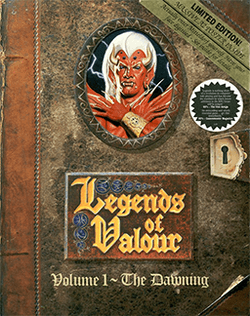Legends of Valour
| Legends of Valour: Volume 1 - The Dawning | |
|---|---|
 Cover art by Fred Gambino | |
| Developer(s) | Synthetic Dimensions |
| Publisher(s) |
U.S. Gold Strategic Simulations, Inc. Ving Co., Ltd. |
| Producer(s) | Nicholas Beliaeff (SSI) |
| Designer(s) | Kevin Bulmer, Ian Downend |
| Programmer(s) | Ian Downend, Graham Lilley, Paul Woakes |
| Artist(s) | Kevin Bulmer, Nigel Bunegar, Kate Copestake, Steve Drysdale, Mo Warden, Fred Gambino |
| Composer(s) | Ben Daglish, Martin Walker |
| Platform(s) | PC DOS (1992), Amiga (1993), Atari ST (1993), PC-98 (1993), FM Towns (1994) |
| Release date(s) | 1992 |
| Genre(s) | Role-playing video game |
| Mode(s) | Single-player |
Legends of Valour is a role-playing video game developed by Synthetic Dimensions and released by U.S. Gold and SSI in 1992 for the Amiga, Atari ST and PC DOS systems, with the additional FM Towns and PC-98 versions in 1993-1994 in Japan only (as Legends of Valour: Gouyuu no Densetsu[1]). As the game was planned to be a first part of the series, its full title is Legends of Valour: Volume I ~ The Dawning.
Plot and gameplay
Advertisements for Legends of Valour claimed "Ultima Underworld, move over! ... Experience the hottest, smoothest 3-D scrolling graphics ever in an underworld, or any world!"[2] Like Ultima Underworld the game is seen in first-person perspective, being one of the first RPG games after it to use a smooth-scrolling three-dimensional environment engine in the style of Wolfenstein 3D. The game also features a point-and-click interface, an either automated or realtime combat, and day/night cycle. The game's system is quite complex and realistic for its time. For example, the player character can become drunk (impairing movement and vision), and be arrested for this; undernourished characters (the players need to eat, drink and sleep regularly) are more likely to catch a disease; and a passing guard may overhear an illegal conversation. Fantasy world of Legends of Valour is inhabited by humans, elves and dwarves, and the player can choose which of these races he wishes to play as (the chosen race influences relations with other characters), with player-customized gender, face and body build for the character.
The game takes place in a walled capital city called Mitteldorf, where the player can explore the streets, buildings and a massive network of dungeons and sewers connected through a natural cave system, while completing various missions given by its numerous citizens, all while looking for his/her missing cousin Sven (named Gareth in the early version), which is the starting point of the game's main quest (to restore the king to power and slay an evil demon). Mitteldorf is over a square mile in size and among its many buildings are several taverns, hostels, shops, guilds, temples, prisons as well as other places of interest (well over 100 locations in total). The guilds and temples offer the player career paths with unique missions; through the game, the player's character can even become a vampire or a werewolf.
Reception
The PC version was generally poorly received. Computer Gaming World called the game "a stimulating new perspective on fantasy role-playing",[3] but strongly criticized its "general lack of atmosphere" and other "numerous deficiencies", including the difficulty in saving the game or finding food, drink, and sleep. Despite liking the 3-D VGA graphics, the magazine warned that the "grandiose claims" SSI made about the game and Spelljammer: Pirates of Realmspace threatened the company's "long-standing reputation for quality".[4] It received 2 out of 5 stars in Dragon.[5] According to VideoGames & Computer Entertainment, "Legends of Valor is an ambitious attempt that couldn't get itself out of the starting gate."[6]
The Amiga version was received much better, including being rated the scores of 91% by Amiga Format and 88% by CU Amiga and Amiga Power.[7]
Legacy
Bethesda Softworks's Todd Howard cited the game as an influence on Bethesda's RPG series The Elder Scrolls.[8] The first game in the series, The Elder Scrolls: Arena, was inspired by "the unheralded" Legends of Valour and Ultima Underworld.[9] Todd Peterson said: "There was another game that came out while we were working on Arena called Legends of Valour, which was a free-form first-person perspective game that took place in a single city. It got pretty pitiful reviews and not many people bought it, but I really had fun with it. It's completely forgotten nowadays, but I probably logged more hours playing it than any other game."[10]
References
- ↑ "Legends of Valour: Gouyuu no Densetsu". GameSpot.com. 1993-11-27. Retrieved 2013-11-14.
- ↑ "A Technological Breakthrough in 3-D Action Fantasy!". Computer Gaming World (advertisement). January 1993. p. 63. Retrieved 5 July 2014.
- ↑ Computer Gaming World 99, page 48
- ↑ Miller, Chuck (May 1993). "SSI Introduces U.S. Gamers to Legends of Valour". Computer Gaming World. p. 42. Retrieved 7 July 2014.
- ↑ Lesser, Hartley; Lesser, Patricia & Lesser, Kirk (August 1993). "The Role of Computers". Dragon (196): 59–63.
- ↑ VGCE March 1993, page 85
- ↑ "Legends of Valour". Lemon Amiga. 2004-07-12. Retrieved 2013-11-14.
- ↑ Ben Hanson, "Road To Skyrim:The Todd Howard Interview", Game Informer, January 13, 2011
- ↑ "The Elder Scrolls 10th Anniversary". Web.archive.org. 2007-05-09. Archived from the original on May 9, 2007. Retrieved 2013-11-14.
- ↑ "Ted Peterson Interview I - Planet Elder Scrolls". Planetelderscrolls.gamespy.com. 2001-04-09. Retrieved 2013-11-14.